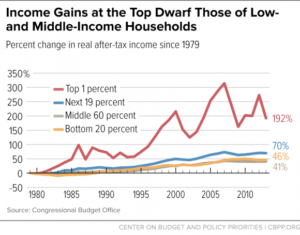Single Payer Health Reform – A Solution For U.S. Income Inequality?
Posted on | October 26, 2017 | Comments Off on Single Payer Health Reform – A Solution For U.S. Income Inequality?

Mike Magee
Veteran Health Policy expert, James A. Morone, Ph.D., makes an interesting argument for single payer health care in this week’s NEJM. In proposing a sweeping change that would directly address “the American patchwork”, assert “the norms of communal decency”, promote planning and efficiency, and empower “a righteous band of reformers, deeply committed to a cause, pushing against all odds”, he does not sidestep higher taxes on the rich.
Rather he sells into them, presenting high taxes on the rich in return for universal health coverage as “on a short list of available policies designed to push back on inequality.
His argument boils down to the fact that a certral element of the national crisis we call “Trump” is populist anger grounded in remarkable income inequality. In roughly a half-century, our separation between rich and poor which used to mirror France and Japan, now aligns with Mexico and Brazil.
In short, we’re a mess, and our citizens are pretty fed up. And why shouldn’t they be? Our top 1% controls roughly 40% of all wealth, while the bottom 90% manages a paltry 23%. If you’re a white family in America, you were born lucky. On avaerage, your family is about 10 times as wealthy as your black family counterpart.
But what about taxes, and distrust of “Big Government”? Morone reminds us that major policy changes can, and have, flipped on a dime in the past. As he says, “Disruptive populism ended past American gilded ages, and it shows signs of challenging the current one.” With better health delivery, and more equality and social justice, we might also redirect the course of American politics and American politicians.
In the same issue of NEJM this week, Henry J. Aaron, Ph.D., explores different roads to reform, raising legitimate concerns about the unintended consequences of disrupting existing insurance holders, and arguing for a more cautious incremental approach including extending availability of Medicare and Medicaid to others, and shoring up ACA exchanges. He wonders how far and how fast are Americans willing to go?
This week, New York Times columnist, Thomas Friedman, shared his view. He didn’t pull punches when he accused Trump of intentionally undermining the two critical pillars of American society, truth and trust.
Interestingly, in the careful analysis of these two health policy experts above, both identify an embattled and epic American struggle over how to topple the health care status-quo, a Medical-Industrial Complex controlled and directed by members of the 1%, and a debate that currently hangs on whether we – the citizens – are able to discern fact from fiction.
The key question for health reform and for the future of America: Do we trust a government “of, by, and for the people” to assure that each of its citizens has the right to “life, liberty, and the pursuit of happiness?”
If a majority of us can move to “yes” on that question, we will find a way to embrace each other equally through health reform. And the quality and durability of that embrace will be determined by these Code Blue principles:
1. Universality: Health coverage is a right of citizenship.
2. Public Administration: Administration of basic health coverage is organized in the most cost-efficient manner possible with central oversight by the government.
3. Local Control of Delivery: The actual delivery of services is provided by health professionals and hospitals at the local and state levels.
4. Health Planning is a Priority: Creating healthy populations is a high priority on the federal and state levels.
5. Transparency: Providers submit bills. Government ensures payment of bills. Patients focus on wellness or recovery.
Tags: health care a right > health care reform > Henry J. Aaron > James A. Morone > NEJM > single payer > Thomas Friedman > universal health care


